#Monotype Bodoni
Explore tagged Tumblr posts
Photo

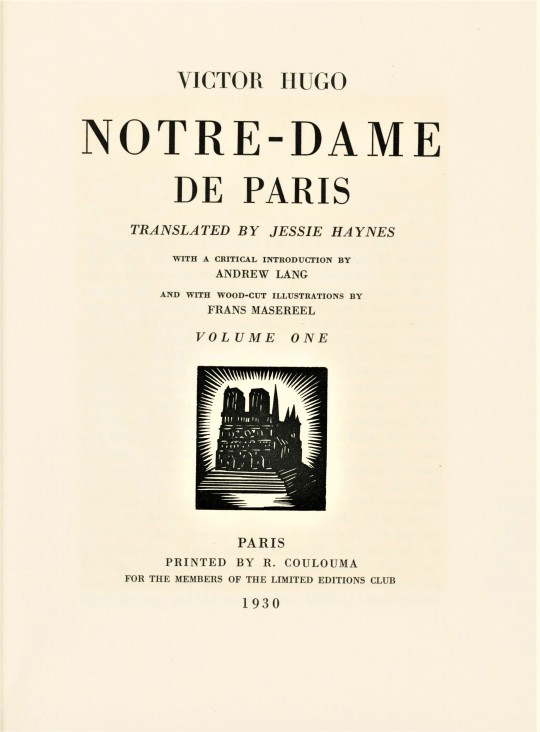


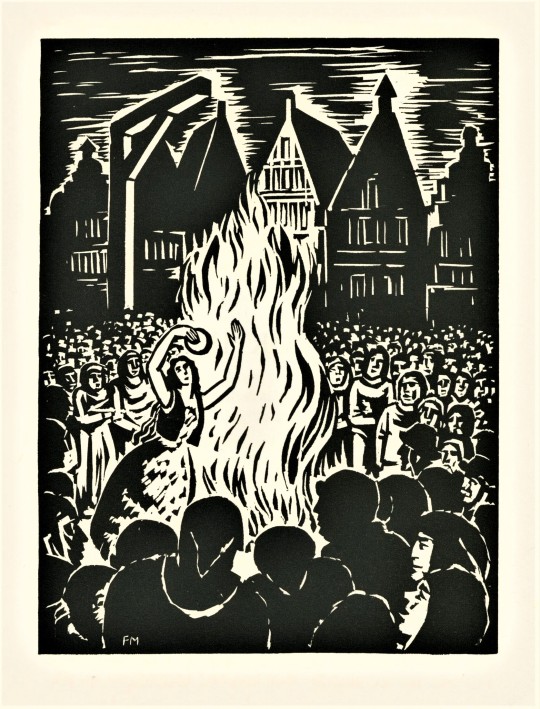


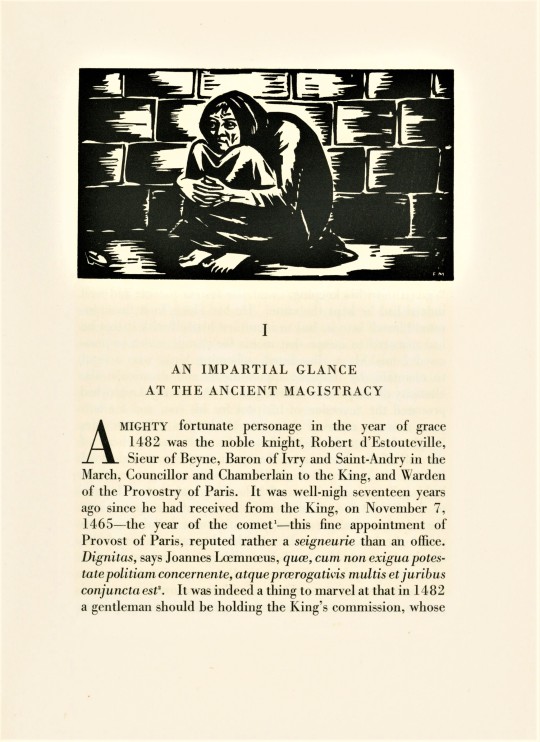
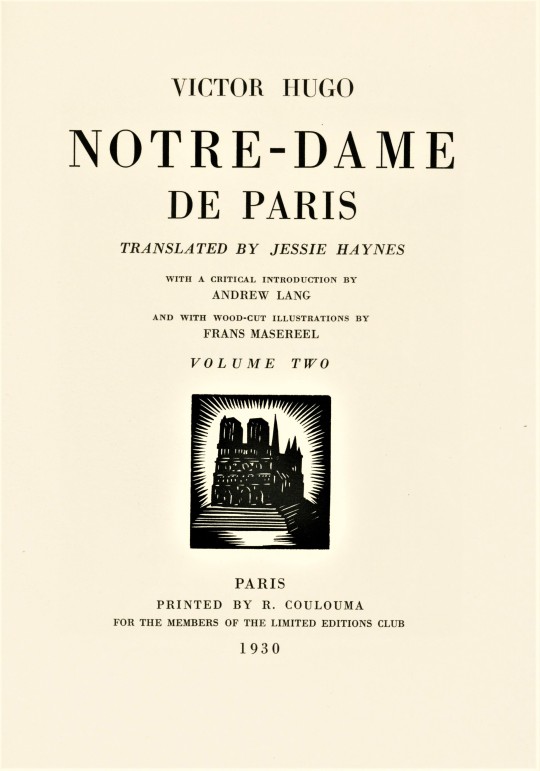
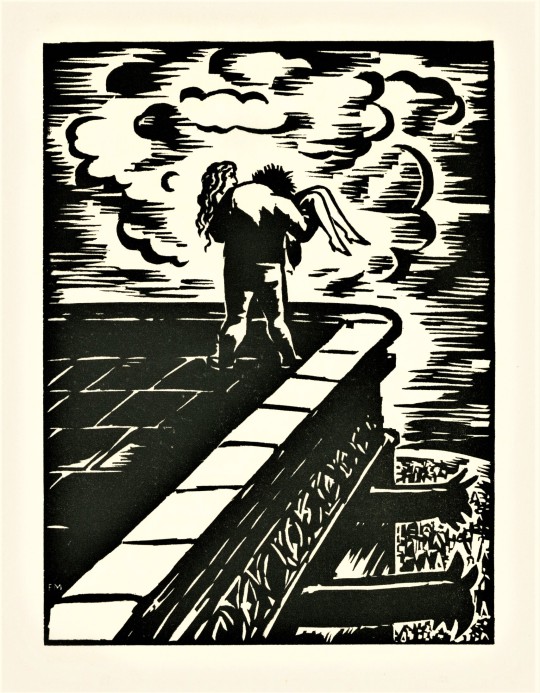
Fine Press Friday
This week we are sharing Notre Dame de Paris, by Victor Hugo, translated by Jessie Haynes, illustrated by Flemish artist Frans Masereel (1889-1972), and printed by French printer and typographer Robert Coulouma for the members of the Limited Editions Club in 1930. Victor Hugo’s novel Notre-Dame de Paris was originally published in Paris in 1831, and first published in English in 1833.
This edition, illustrated in wood-engravings by Masereel, is printed in two volumes which are divided into 11 books, each book begins with one full page illustration and a chapter header. Including the frontispiece there are 23 unique illustrations.
Masereel worked primarily in France. He produced many wordless graphic novels in relief printmaking and has been described as a father of the modern graphic novel. He was also key figure in the revival of the relief print, which has been used to illustrate books since the introduction of moveable type in the 15th century. Masereel’s cleanly cut, easy-to-read relief prints compliment the typography making it well suited to the book format.
The paper is Velin d’Arches and he book was set in Monotype Bodoni and printed by Robert Coulouma, master printer in Argenteuil, under the supervision of artist and designer Henri Barthélemy. Both Volumes are bound in a soft paper cover.
Our copy is a gift of Loryn Ramadka, from the collection of Austin Frederic Lutter. Printed in an edition of 1500 copies, our copy is number 1113, the number for long-standing LEC member Austin Fredric Lutter of Waukesha, Wisconsin. This set is signed by the illustrator in the colophon.
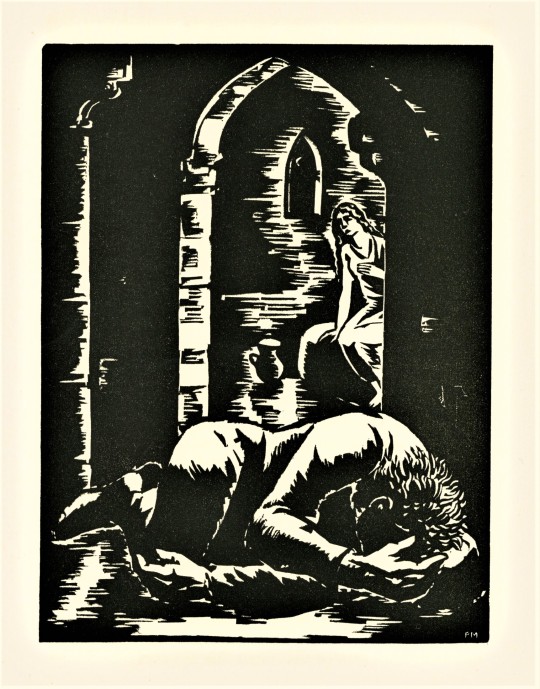

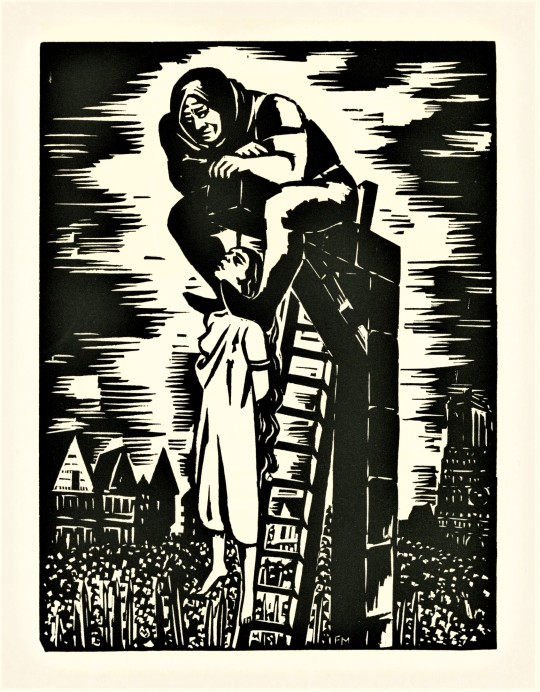

View more Limited Edition Club posts.
View more Fine Press Friday posts.
View another Fran Masereel post.
Teddy, Special Collections Graduate Intern
#Fine Press Friday#Frans Masereel#Limited Editions Club#Fine Press books#Wood Engraving#Black and White Illustration#Fine press printing#book arts#Teddy#Notre Dame de Paris#the hunchback of notre dame#Notre Dame#French Books#flemish artists#belgian artists#relief printmaking#wood-engraving#Robert Coulouma#Henri Barthélemy#Fine Pres Fridays#Velin d’Arches#Monotype Bodoni#Bodoni type
88 notes
·
View notes
Text

dante roman
passage from Ulysses by james joyce [the bodley head, london, 1967 (seventh impression, w/ corrections), p188].
set in digital reissue of monotype dante roman. dante is the 20th c. statement of renaissance inspired roman & italic by consummate typographer-printer giovanni mardersteig. the founts were initially proprietary to maredrsteig’s private press, the officina bodoni; first showning was a handset edition of boccaccio, Trattello in laude de Dante [officina bodoni, verona, 1955]—typeface name thus acquired. the punches were engraved by one of the last gifted punch-cutters, charles malin of paris, & subsequently served as basis for monotype’s pantograph-engraved matrices; monotype dante first issued in 1957 [english monotype 592]. [cf. john dreyfus, The Work Of Giovanni Maredersteig with Monotype Faces, the monotype corporation, london, 1967.]
finishing fleuron pair selected from p22 victorian. of their provenance—no clue.
for the dante italic vide ‹bembismo 2›.
3 notes
·
View notes
Note
top five fonts!!!!!

oh shit oh fuck ok this is really tough bc of how contextual fonts are but so i think i gotta do one for general common uses my workhorse besties and another for my fun accent fonts
again in no particular order right now my standbys are
garamond my best friend. i like adobe garamond the best out of all the versions cuz she’s a little tighter and has a little bit of a smaller x height really sets a great mood
mrs. eaves is another fun serif i think she’s fun and quirky and i use her a lot
i like futura!! she’s good you don’t mess with a classic i don’t care if some people think it looks dated the 70s are coming back
theinhardt is a great all-purpose font that used to be my "brand" font for my resumes etc. people act like sans-serifs are all the same or all easy to design but that's not true!! i think this font is a really great example of how clean and timeless a well designed sans-serif can look
hhhh okay for some variety my last one is gonna be DIN even tho it's tied with a bunch bc 1) i love grotesks and there isn't one on this list yet and also the condensed version is great
for more statement fonts i love:
bodoni is a classic but for a reason. it's used in a lot of branding/magazines and i get why it feels luxurious. like garamond it has a million versions but the one i like/have become accustomed to is bodoni 72
justice for handwriting fonts some of them can be GOOD actually. clattering is a font i love that i've been wanting to find a use for for a while
programme is a really fun statement font and i'd love a reason to use their rotated version
i'm a sucker for a big wide slab serif as a statement font. my current goto for that is mighty slab
bc alphapipe is another font i love as a piece of design and wish i could find an application for
apologies for all the adobe links 🤢 that's often where i source my fonts. anyway please remember that just like with pirating blockbusters vs indie films, font design is hard work and designers are rarely compensated fairly for the massive time investment font design can be. pirate from the big typehouses like monotype. don't pirate fonts from indie creators.
#thank you!!#niche interest completely activated i spent at least 20 min on this#hailing frequencies open
9 notes
·
View notes
Text
My Favourite Fonts
As we learnt before there are many aspects that are important in making a certain design look and feel great. This time, we’re going to look into another aspect that is important in design which are Fonts. There can be many types of font such as serif fonts, sans serif fonts and decorative fonts. Today i’m going to share two of my favorite fonts that I really like.

First of all is Century Gothic which is a sans serif font that was released by Monotype Imaging back in 1991. The reason I really like this font is because of the clean-cut look to it making it suitably to use either as a header or a body copy text. This font is strongly based on another font named Futura which has a similar look to this font.

My second favorite font is a modern typeface named Bodoni. It was created back in 1788 by Giambattista Bodoni. This font is classified as a serif font. The reason I like this font is because of it’s clean look making it feel very elegant. This font is commonly used in fashion advertisements and magazines such as Vogue magazine.
There are many more fonts that can be found in the Internet and all of them are very useful to make different designs that have their own unique feel to it.
1 note
·
View note
Text
Additional Color and Type Information
Type
Didot
Designer: Firmin Didot
Foundry: Designed for his father’s foundry
Year: 1784
Bodoni 72
Designer: Dmitry Kirsanov
Foundry: ParaType
Futura Pt
Designer: Vladimir Yefimov and Isabella Chaeva
Foundry: ParaType
American Typewriter
Designer: Joel Kaden and Tony Stan
Foundry: ITC
Year: 1974
Helvetica Neue
Designer: Nadine Chahine, Linotype Design Studio, Monotype Design Studio, and Edik Ghabuzyan
Foundry: Linotype
Year: 1957
Escafina
Designer: Riley Cran
Year: 2014
Liberator
Designer: Ryan Clark
Color
Fourth Choice
Palette 1:
Pantone 1915 C
Pantone 1905 C
Pantone 706 C
Pantone 12-0712 TCX
Palette 2:
Pantone 4080 C
Pantone 2074 C
Pantone 577 C
Pantone 5815 C
Third Choice
Palette 3:
Pantone 11-0604
Pantone 13-0324
Pantone 14-1324
Pantone 13-3805
Second Choice
Palette 4:
Pantone 13-1404
Pantone 14-1315
Pantone 18-1018
Palette 5:
Pantone 191 C
Pantone 183 C
Pantone 732 C
Palette 6:
Pantone Warm Gray 1 C
Pantone 4066 C
Pantone 2445 C
Palette 7:
Pantone 191 C
Pantone 11-0604
Palette 8:
Pantone 14-1324
Pantone 732 C
First Choice
Palette 9 (combo of 7 & 8):
Pantone 191 C
Pantone 11-0604
Pantone 14-1324
Pantone 732 C
Color Meaning
Pinks: friendship, affection, harmony, inner peace, and approachability
Browns: steadfastness, simplicity, friendliness, dependability, and health
Purples: creativity, wisdom, dignity, grandeur, devotion, peace, and pride
Greens: growth, harmony, freshness, and fertility
Grays: formal, conservative, and sophisticated
Creams: neutral, calm and relaxing
1 note
·
View note
Text
Las Tipografías Más Utilizadas En Diseño Gráfico
1. Gotham
Gotham es una tipografía diseñada por Tobias Frere-Jones en el año 2000. Está inspirada en el grupo de las Sans-Serif (palo seco) y del estilo arquitectónico popular de mediados del siglo XX en la ciudad de Nueva York.Muchos comparten que es una tipografía con mucha personalidad y transmite confianza, por esta razón hemos podido encontrarla en diferentes campañas políticas entre las más destacadas la de Barak Obama en el 2008. Por otro lado el programa de música online Spotify, también la utiliza en su versión digital sustituyendo a la Helvetica Neue.

2. Bodoni
Bodoni es una fuente creada por Giambattista Bodoni (Parma, 1740-1813). Una tipografía que combina muy bien los trazos gruesos y finos transmitiendo una gran elegancia. Bodoni ha sido utilizada en revistas como Vogue o Harper’s Bazaar y en muchos de los periódicos de los años 60, incluso por la banda Nirvana.

3. Futura
Futura es una tipografía sans serif diseñada por Paul Renner en 1928. Futura es uno de los tipos de letra más conocidos y utilizados de las tipografías modernas. Varias compañías como Volkswagen, Boeing o Ikea la han usado como parte de su diseño corporativo. En el siglo XX fue muy usada y en la actualidad continúa siendo muy popular.

4. Gill Sans
Gill Sans es una tipografía sans serif o paloseco fue creada por el tipógrafo Eric Gill y publicada por Monotype 1928 y 1930. Ha sido usada en empresas importantes como el metro de Londres y British Railways, y en España la hemos podido ver en Televisión Española entre 1990 a 1997 en toda la grafía y maquetación de los programas.

5. Garamond
Garamond es una tipografía con serif > Romanas clásicas > Antiguas. Creada por Claude Garamond en el siglo XVI en Francia. Una de las más influyentes de la historia y también una de las mejores romanas jamás creadas.En 1984 fue adoptada por Apple para el lanzamiento del Macintosh y fue modificada posteriormente por Myriad.

6. Avant Garde Gothic
Avant Garde es una fuente inspirada en logo de Herb Lubalin en 1970 para la revista Avant Garde Magazine en 1967. Una tipografía geométrica de líneas rectas y figuras circulares basadas en el movimiento Bauhaus de los años 20.

7. Baskerville
Baskerville es una tipografía con serif diseñada en 1757 por John Baskerville en Birmingham. Su gran delicadeza y virtud por el diseño ayudo a influenciar a tipógrafos de la talla de Didot o Bodoni. Estamos delante de una tipografía clara y legible gracias a su diseño (serif) siendo muy apropiada para proyectos editoriales como libros de textos.

8. Franklin Gothic
Franklin Gothic es una fuente sans-serif creada por Morris Fuller Benton (1872-1948) en 1902. Su nombre es en honor al prolífico político, inventor e impresor estadounidense, Benjamin Franklin. Esta tipografía es muy común verla en anuncios y titulares de periódicos.

9. Bebas Neue
Bebas Neue es una fuente creada por Ryoichi Tsunekawa y gracias a su gran popularidad fue nombrada para muchos como la «Helvetica de las tipos gratuitas». Está formada por toda la familia de fuentes: Thin, Light, Book y Regular. Gracias a su elegancia y líneas rectas y la altura de la X, Beabas Neue es ideal para titulares.

10. Akzidenz-Grotesk
Akzidenz Grotesk, es un tipo de fuente paloseco o sans serif diseñada por la fundidora de tipos H. Berthold de la ciudad de Berlín en el año de 1896 por Günter Gerhard Lange. Debido a su gama de anchos es buena opción en espacios reducidos como tablas y titulares de periódicos y revistas.

[Publisher Factory]. Factory by Factory
#tipografia#typography#graphic design#diseño gráfico#garlaydesign#arte#graphic art#graphic#creative#creatividad#designtypography#diseñotipografico#design#agencydesign#bcndesign#diseño
8 notes
·
View notes
Text
Geschichte Von 8 Berühmte Schriftart.

Wussten Sie, dass serifenlose Schriften seit über 1400 Jahren verwendet werden? Wussten Sie, dass Logotype, der erste universelle Standard für Typografie, 1909 geschaffen wurde? Wussten Sie, dass es fast so viele verschiedene Schriften gibt wie Menschen? Dieser Artikel ist eine Ressource, um einige der berühmtesten, nützlichsten und schönsten verfügbaren Schriftarten kennenzulernen. Es konzentriert sich auf die beiden Haupttypen berühmte Schriftarten , aus denen diese Gruppe besteht: Serif und Sans-Serif. Wir sind keine Fremden für vorinstallierte Schriftarten auf Computern, nicht nur Büroangestellte, sondern auch professionelle Markenlogo-Designer verwenden viel, aber ob Sie die Geschichte von 8 berühmte Schriftarten in der Welt kennen, die von jedermann entworfen und entworfen wurden. Werfen wir einen Blick auf den folgenden Artikel, um mehr über die Geschichte dieser Schriftarten zu erfahren. Werfen wir einen Blick auf die Geschichte der Bildung von Schriftarten, als die berühmtesten Schriftarten der Welt überall waren. Jede berühmte Schriftart, die Sie sehen, enthält eine Geschichte, einen Schöpfer, eine Geschichte und eine Fangemeinde. Wenn Sie Designer werden, erscheinen diese Serifen und Liniengewichte und Sie beginnen, sie in der Szene zu erkennen. Werfen wir einen Blick darauf, wie einige dieser berühmte Schriftarten entstanden sind und Designer mutige Schritte unternommen haben, um das zu schaffen, was unsere visuelle Welt weiter verändern wird. Um die berühmte Schriftarten besser zu verstehen, können Sie die Website https://schriftarten123.com/ besuchen, um weitere Informationen und berühmte Schriftarten zu erhalten.
Berühmte Schrift Helvetica
Entworfen von Max Miedinger und Edouard Hoffman Serifenloser Stil Jahr der Erfindung 1957 Die berühmte Schriftart Helvetica ist eine der Vakuumschriften, die sowohl im Text als auch im Verpackungsdesign, der Firmenprofilgestaltung. Entworfen bei hass foundry in der Schweiz. Miedinger wollte ursprünglich Maler werden, aber sein Vater sagte ihm, dass er sich auf einen praktischeren Beruf konzentrieren müsse. Miedinger entwarf den Stil und schuf 30 Jahre später Helvetica mit Hoffman. Es zielt darauf ab, das Bedürfnis nach einer neutralen berühmte Schriftart zu erfüllen, die bei Beschilderungen, Katalogen, Texten sehr gut angezeigt wird ... Es gilt als eine der am häufigsten verwendeten Schriftarten der Welt. Zu sehen im Film Helvetica. Amerikanische Bekleidung... Viele Websites auf der ganzen Welt verwenden diese berühmte Schriftart . Helvetica ist das offizielle Drehbuch im New Yorker U-Bahn-System. Die weit verbreitete Verwendung von Helvetica selbst hat Monotype, das Unternehmen, das die urheberrechtlich geschützte berühmte Schriftart mit Helvetica herstellt, dazu veranlasst, in jedem Buchstaben einige Änderungen vorzunehmen, um sie im 21. Jahrhundert relevanter zu machen. Dieser neue Satz von berühmte Schriftarten heißt Helvetica Now. Monotype hat viel Zeit damit verbracht, jedes der 40'000 Zeichen der Helvetica-Schriftart neu zu zeichnen, was das Lesen im kleinen Format auf der Produktverpackung oder auf dem Telefonbildschirm erleichtert und weniger langweilig macht. The Verge interviewte Charles Nix, Director of Fonts bei Monotype, um mehr über den Update-Prozess zu erfahren.

Bodoni berühmte Schriftart
Entworfen von Giambattista Serifenschrift Jahr der Erfindung 1798 Als Bodini als offizielle Schreibmaschine für mehrere italienische Herzöge eingestellt wurde. Diese Herzöge genossen seine Arbeit und Arbeit und ermutigten ihn, eine Druckwerkstatt im Palast in Parma zu eröffnen. Und er wurde "der Designer für die Könige und Könige der Designer" genannt. Nach seinem Tod wurden seine geskripteten Werke kombiniert, um die berühmte Schriftart zu schaffen , die wir heute Bodoni nennen. Als es zum ersten Mal veröffentlicht wurde, wurden Bodoni und andere bekannte Schriftarten wegen ihrer stromlinienförmigen Struktur als klassische Designs bezeichnet. Diese berühmte Schriftarten sind jedoch keine aktualisierten Versionen der römischen oder Renaissance-Typografie, sondern neue Designs. Sie werden "moderne" Serifenschriften genannt; Seit Mitte des 20. Jahrhunderts sind sie auch als Didone-Designs bekannt. Einige digitale Versionen von Bodoni sollen aufgrund der "Blendung" durch abwechselnd dicke und dünne Striche, insbesondere sehr dünne Striche bei kleinen Punktgrößen, schwer lesbar sein. Dies ist sehr üblich, wenn die optischen Abmessungen der Schriftart, die für die Verwendung in der Bildschirmgröße entwickelt wurde, in der Textgröße gedruckt werden, zu diesem Zeitpunkt können die Pinselstriche zurückgezogen werden und sind schwer zu sehen. Massimo Vignelli erklärte: "Bodoni ist eine der elegantesten Schriften, die jemals entworfen wurden." In der englischsprachigen Welt werden "moderne" Serifendesigns wie Bodoni am häufigsten in Titeln und Anzeigezwecken sowie im gehobenen Zeitschriftendruck verwendet, der oft auf Hochglanzpapier hergestellt wird, um scharfe Details dieser schönen Berührungen zu erhalten und zu erzeugen. In Europa werden sie oft häufiger im Inhaltstext verwendet.
Famous Times New Roman Schriftart
Entworfen von Victor Lardent 1931 wurde in England die Schrift Times New Roman von der Times of England in Auftrag gegeben, nachdem der Schriftdesigner Stanley Morison die Zeitung für ihre Lesbarkeit kritisiert hatte. Morison unterstützte den hauseigenen Designer Lardent bei der Erstellung dieser berühmten Schriftart, die auf der ganzen Welt weit verbreitet ist. Es ist seit 1992 in jeder Version von Microsoft verfügbar. Wird häufig in Büchern verwendet. Seine hohe Lesbarkeit macht es ideal zum Kopieren. Keine bekannte Schriftliste kann ohne sie vollständig sein. Times New Roman ist eine beliebte Schriftart beim Entwerfen von Text und kann für viele Menschen als die bekannteste Schriftart angesehen werden. Vertriebs-Webdesign-Services wählen oft diese Schriftart oder Vakuum-Fonts wie Arial, Helvetica,... um Leichtigkeit, Komfort zu schaffen. Erfahren Sie mehr über die berühmte Schriftart Times New Roman unter: History of Times New Roman
Futura berühmte Schriftart
Entworfen von Paul Renner Sans Schriftart – geometrische Serife Jahr der Erfindung: 1927 Futura berühmte Schriftarten wegen ihrer Einfachheit und Modernität werden immer noch von vielen Designunternehmen in Logo-Design, Verpackungsdesign, Werbeplakaten verwendet. Dieser Unterschied gehört jedoch zu Erbar, einer Schrift von ludwig & mayer foundry. Futura wurde als Antwort auf die damals beliebte Schriftart entwickelt. Da die Bauer-Gießerei viel größer ist als die Ludwig & Mayer-Gießerei, ist Futura eine berühmte Schriftart, die den Test der Zeit besteht. Bis jetzt, 85 Jahre nach seiner Gründung, haben Wortworkshops viel Futura im digitalen Format auf den Markt gebracht. Adobe ist eines der beliebtesten. Der Erfolg von Futura war das Vorbild für viele der geborenen geometrischen serifenlosen Schriften wie Kabel und Century Gothic und viele andere. Statement of Popularity: Unzählige Filmplakate, darunter Gravity, American Beauty, Gone Girl und Interstellar sowie TV-Shows wie Lost und Sesamstraße. Wird ausschließlich in der hochgelobten Graphic Novel Watchmen verwendet. Es ist die beliebteste berühmte Schriftart der berühmten Regisseure Wes Andersen und Stanley Kubrick und wird oft in ihren Filmen gezeigt.

Berühmte Frutiger-Schrift
Entworfen von Adrian Frutiger Schrift: serifenlos Jahr der Erfindung: 1974. Frutiger, ein Schweizer Designer, wurde von der US-amerikanischen Gießerei Mergenthaler Linotype beauftragt. Als sie eine gedruckte Version der Roissy-Schrift wollten, die er für das Schild am neuen Flughafen Charles deGaulle in Paris entworfen hatte. Frutiger glaubt, dass Schriftarten mit Klarheit und modernen Funktionen beim Drucken auf allen Materialien einfach zu verwenden sind und sehr gut erkennbar sind. Frutiger wurde ursprünglich als große Schrift für Fluggesellschaften verwendet, aber in den letzten Jahren wurden Schriftarten auf Body-Text-Snippets in Zeitschriften angewendet. Dies ist eine Form von serifenlosen Schriften ähnlich wie Futural oder Helvetica, so dass Sie zwischen diesen drei Arten von Schriftarten flexibel sein können! Erklärung der Popularität: Schriftarten werden offiziell für viele Colleges und Universitäten verwendet, darunter das Claremont McKenna College, die Cornell University und die University of Southern California. Auf dem Schild für die öffentlichen Verkehrssysteme Bay Area Rapid Transit (BART), Amtrak und Sydney CityRail. Vor allem Frutigers bemerkenswerteste kann als seine Position auf den offiziellen Euro-Banknoten der Europäischen Union angesehen werden.

Berühmte Schriftart Avenir
Entworfen von Adrian Frutiger Schriftart: geometrisch serifenlos Herkunft: 1988. Avenir ist das End-of-Life-Design des Frutiger-Designers Adrian Frutiger. Der Designer betrachtet diese berühmte Schriftart als seine beste Arbeit, die in vielen Werbetafeln und grafischen Publikationen verwendet wurde. Die berühmte Avenir-Schriftart eignet sich hervorragend für Logos, Marken, Einladungen, Briefpapier, Hochzeitsdesigns, Einladungen, Logos, Visitenkarten, Cover, auf Hemden, Social-Media-Posts und mehr. Es wird auch verwendet, um ein großartiges Bild, Text mit einer Vielzahl von Farben und Text zu erstellen. Erklärung der Popularität: Offizielle berühmte Schriftarten für die Firmenidentität der Stadt Amsterdam, einschließlich des berühmten I amsterdam-Schildes. Apple verwendet Avenir für sein Mapping-Programm. Eine speziell für Best Buy erstellte Version heißt Avenir Next for Best Buy.

Berühmte Schriftart Garamond
Entworfen von Claude Garamont Schrift: altmodische Serife Es ist eine der bekanntesten berühmte Schriftarten, die seit etwa 1530 in Frankreich in einer Zeit politischer und sozialer Unruhen verwendet werden, dies ist eine Ära, in der neue Schriften benötigt werden, um neue Ideen auszudrücken. Diese Schrift wurde später von französischen und deutschen Gießereien nach Garamonts Tod erworben und im 20. Jahrhundert für die Verwendung als Schriftart wiederbelebt. Interessanterweise wurde die Garamond-Schrift zu einer der ersten berühmten Schriften, als sie 1900 auf der Pariser Weltausstellung vorgestellt wurde, mit Dutzenden von Variationen, die diesen Stil nachahmen. Garamonds Ruf wuchs in den folgenden Jahrzehnten stark. Garamond hat ein elegantes Aussehen. Die Buchstabenstifte an jedem Charakter sind sorgfältig gefertigt, um seine Persönlichkeit zu vermitteln, vor allem der Großbuchstabe "T". Weil die Fußnoten der einzelnen Charaktere so ausdrucksstark sind, wurden sie in einem spielerischen Kontext verwendet – wie in den frühen Jahren der Marke Apple. Dank der Verfeinerung wird diese Schriftvorlage auch verwendet, um das weise Symbol auszudrücken, genau wie im American Eagle-Logo oben. Berühmte Anforderungen: Wird hauptsächlich zum Kopieren verwendet. Es bleibt die berühmte Schriftart im französischen Buchverlagswesen. Vorgestellt im Abercrombie & Fitch-Logo. Berühmt für seinen Zweck könnte die USA 400 Millionen Dollar aufgrund seiner leichteren

Berühmte Schriftart akzidenz-Grotesk
Entworfen von Berthold Type Foundry Schriftart: frühe serifenlose (grotesk) Herkunft: Gerüchten zufolge war er 1898 in der berthold Type Foundry kreativ. Die genaue Herkunft ist ungewiss und viele Designer gelten als die Schöpfer dieser berühmten berühmte Schriftart . 1950 wurde die Typografie von Bertholds damaligem Direktor Günther Gerhard Lange überarbeitet und erweitert. Es ist diese Version, die jetzt am häufigsten verwendet wird. Berühmte Aussage: Offizielle Schriftart des Amerikanischen Roten Kreuzes. Wortmarkenschrift für das Basketballteam Brooklyn Nets. In den 1960er Jahren war er in einer Reihe einflussreicher Volkswagen Printanzeigen zu sehen. Produktschriften für viele Braun-Elektronik.

Lesen Sie mehr über Akzidenz-Grotesk unter: Akzidenz-Grotesk Read the full article
0 notes
Text
4 Useful Tips For Choosing Your Perfect Led Neon Sign

Type of Neon Sign
Presently, when it comes to the type of Neon Sign, Led Neon Sign gains much popularity and is supposed to be the perfect choice to utilize compared to traditional tubing one because this one helps you save electric energy, be more durable, lightweight and safe to touch. One more thing is that no limits to customizing your own sign and the price is rather cheaper than you supposed. However, each type creates a different look so just see which type fulfills your wants or the client’s demands most to select your right sign.
Size of Neon Sign
This step is so important and has possible impacts on the overall appearance of your led sign so please measure your space carefully and make sure it will be big enough to see clearly. Just imagine your customized quote looks so gorgeous but your sign is too small to see from several meters. How sad you would be! As soon as you step into the space, your led sign should be a terrific focal point and provide an eye-catching feature.
Color of Neon Sign
Color is thought to be the most difficult aspect of selecting the perfect Neon Sign. They come in over a hundred different colors! Consider the color after you’ve decided on a logo for your company. What effect does the color of Neon light has on the atmosphere in your environment? After you’ve reached an agreement, include them in the LED signs. You can easily choose your favorite color with beautiful designs with our Multi-Color Neon Signs collection.
Font Styles
The very first thing you need to notice is that do not choose difficult-to-read fonts such as Bodoni, Comic Sans, Haettenschweiler, or Monotype Corsiva. As a result, it’s usually advisable to avoid cursive writing. The ideal option is to choose a large text in a color that contrasts with the background of your sign. You can give a second look at our fonts listed on Design your own design or visit this site for more. We suggest top best neon sign font for your custom neon sign that will be perfect for you.
Perfect Led Neon Sign
MK Neon is in the top 5 neon sign companies in the market, due to our great quality/price ratio with our patented neon tube. We are making custom LED neon signs. Customer will reach out to us and have the choice to purchase a LED neon from our collection, build their own neon with our online neon customizer tool or submit an inquiry through our form with their logo.
0 notes
Text
Type Report 5.24 - Jingxiao Wu
Bodoni

Bodoni is first designed by Giambattista Bodoni in the late eighteenth century. It is a serif typeface and is widely used in different materials. When first released, Bodoni type is called classical design because of their rational structure. However, when it is used in long sentences or long passages, its contrast of thick and think strokes may confuse readers. It is now widely used in magazine and fashion advertisement due to its modern structure and chic style.

Plantin

Plantin typeface is named after the sixteenth-century printer Christophe Plantin. It is designed by Frank Hinman Pierpont in 1913. Published by Monotype. Originally designed by Robert Granjon in about 1700. It is an old-style serif typeface. Plantin typeface is a very solid design, which was often particularly used by trade and newspaper printers using poor-quality paper in the metal type period and beyond.

0 notes
Text
MONOGRAMA
Práctica 05
Para la construcción del monograma, se utilizó la tipografía “Baskerville”. Esta, según lo analizado en las lecciones, se caracteriza por tener remates o serifas. Su construcción se fundamenta en sistemas de proporción y es considerada elegante y sobria. Suele utilizarse en textos literarios, ya que evoca el carácter humanista y además se considera como una tipografía apta para la lectura de textos largos.
LA HISTORIA DE BASKERVILLE: UN VIAJE AL SIGLO XVIII
Baskerville es una tipografía que fue diseñada en el siglo XVIII por John Baskerville, un tipógrafo inglés que, según diversas fuentes indican, era caracterizado por su delicadeza, elegancia y claridad en el diseño de los tipos y composición de las páginas. Incluso, en 1758, fue nombrado impresor de la Universidad de Cambridge (Benito, 2018), y la calidad de sus impresiones influyó a grandes tipógrafos como Didot y Bodoni.
Luego de fallecer, sus tipos permanecieron ocultos durante más de 150 años, hasta que Bruce Rogers, un diseñador norteamericano, los rescató y reeditó. De esta reedición surgieron Monotype en 1924 y Linotype en 1931. Se dice que la tipografía “Baskerville” posee proporciones “generosas”, es legible y clara.
“La historia de John Baskerville, el famoso impresor inglés del siglo XVIII, es por encima de todo una historia de amor por las letras. Definido por muchos estudiosos como el «impresor total» debido a que abarcó todas las facetas del negocio de la imprenta, han sido sus diseños tipográficos los que han llegado hasta nuestro tiempo como un gran representante de las tipografías neoclásicas. Conocedor de las nuevas propuestas que incorporaba la romain du roi, conjugó sus formas con las más exquisitas muestras de los calígrafos ingleses de la época.” (Redacción UTD, 2008).
SOBRE EL MONOGRAMA CREADO: ¿POR QUÉ BASKERVILLE?
El ejercicio 05 tenía como finalidad crear un monograma que nos represente. Cabe recordar que un monograma es “un diseño que incorpora dos o más letras que se conectan de diversas maneras”. Estas letras pueden estar entrelazadas, rodeadas por un borde o simplemente ordenadas de cierta forma. La mayor parte del tiempo, el monograma está hecho a partir de un conjunto de iniciales, y las tres letras del monograma clásico son las iniciales del nombre y apellidos de la persona.
En este caso, elegí mis dos iniciales (tanto de mi nombre como de mi apellido) y las unifiqué. Me incliné por Baskerville, ya que considero que es una tipografía con trazos legibles y agradable en los ojos de un lector. Esto tiene gran importancia, ya que, en mi caso, leo y escribo de manera habitual. Es decir, un aspecto fundamental que busco como lectora es una fuente que no me genere cansancio en la vista, y como escritora siempre existe un interés en presentarle al lector un texto que pueda digerir fácilmente sin que las letras le resten atención al mensaje.
Por estas razones considero que Baskerville es una fuente que se adapta a mi personalidad: tiene un estilo clásico y elegante, pero no se sobrepone al mensaje, sino que genera un balance visual. Es decir, no pasa desapercibida en los ojos del lector, pero tampoco se trata de una fuente tan llamativa que el enfoque se plasma únicamente en los trazos, perdiéndose el mensaje.
De igual forma, opté por unir la A y la V en sus extremos, haciendo alusión a un mensaje fluido y libre de interrupciones en el trazo. Se pretende generar un sentimiento de continuidad entre ambas y que le permita al lector enfocarse en ambas letras a la vez.
SOBRE EL USO DEL COLOR
Para el monograma utilicé tres colores principales:
Rojo: E41C05
Naranja: FC7041
Amarillo (pastel): FCD4A5
Se trata de una paleta de colores cálidos y llamativos. La idea central alrededor del uso de estos colores es capturar parte de mi personalidad extrovertida.
Referencias:
Benito, M. (2018). Baskerville. Poscultura, el nombre de la cultura. https://poscultura.com/tipologias/baskerville/
Letrag – Enciclopedia en línea de tipografías; clasificación por familias tipográfica e historia. https://es.letrag.com/tipografia.php?id=9
El Poder de las Ideas. (24, 04, 2016). ¿Qué es un monograma? El Poder de las Ideas [Blog]. Recuperado de https://www.elpoderdelasideas.com/que-es-un-monograma/
0 notes
Text
Making Decisions - Typeface
Narrowing down the choice of typefaces, I finally chose to use Bodini and Gill Sans for my spreads.
Bodoni




Bodoni is the name given to the serif typefaces first designed by Giambattista Bodoni in the late eighteenth century and frequently revived since. Giambattista Bodoni had a long career and his designs changed and varied, ending with a typeface of a slightly condensed underlying structure with flat, unbracketed serifs, extreme contrast between thick and thin strokes, and overall geometric construction. In the English-speaking world, "modern" serif designs like Bodoni are most commonly used in headings and display uses and in upmarket magazine printing, which is often done on high-gloss paper that retains and sets off the crisp detail of the fine strokes. In Europe, they are more often used in body text.
Gill Sans





Gill Sans is a humanist sans-serif typeface designed by Eric Gill, a British sculptor, engraver, typographic designer, and writer, especially known for his elegantly styled lettering and typefaces and the precise linear simplicity of his bas-reliefs. Gill Sans was released by the British branch of Monotype from 1928 onwards. Gill Sans is based on Edward Johnston's 1916 "Underground Alphabet", the corporate font of London Underground. Gill Sans does not use the single-storey "g" or "a" used by many sans-serifs. Its structure is influenced by traditional serif fonts such as Caslon rather than being strongly based on straight lines and circles as Futura is. Gill Sans has influenced many other typefaces and helped define a sans-serif genre, known as the humanist style.
0 notes
Photo










Typography Tuesday
A few weeks ago we presented some broadsides exhibiting a variety of typefaces from a collection of forty broadsides entitled Forty Sheets to the Wind, printed by Graham Moss and Kathy Whalen in 1999 to showcase the enormous collection of typefaces at their Incline Press in Oldham, England. The portfolio is part of a set of 150 copies that also includes a letterpress-printed introductory booklet.
Today we present ten more typographic broadsides from this collection. Here is some commentary on each broadside from the booklet, from top to bottom:
Because they have enormous rumps: Derek Barlow’s rhyme is set in 24 pt Scotch italic and is accompanied by Peter Allen’s illustration of a joyful elephant.
The Cat & The Fiddle: Set in Berthold Wolpe’s 14 pt and 36 pt Albertus, with illustrations by Claud Lovat Fraser.
To a Fish of the Brooke: Peter Pindar’s poem is set in 14 pt Cochin from M&H Type Foundry and printed on handmade Canterbury paper from Barcham Green. The illustration is an Edwardian-era commercial cut.
Tiger, tiger, burning bright, etc.: Set in 18 pt Verona type from Stephenson Blake and printed on handmade Sheepstor paper. The illustrations on the right are enlargements from Thomas Bewick’s wood engravings; the illustration on the left is an enlargement from an electroplate from Stephenson Blake.
Old Mrs. Marley: Claud Lovat Fraser ‘s text is set in 24 pt Optima with a 12 pt byline, a typeface designed by Hermann Zapf and issued by the Stempel foundry in 1958. The illustration is a Victorian-era commercial cut.
A brown mousey loved a swine: A Scottish folk rhyme set in 18 pt. Verona, with a 12 pt footnote and 14 pt italic to finish. The illustrations are original wood engravings by Sybella Stiles.
The Rainbow Workshops: The main text is set in Jan Van Krimpen’s Lutetia from Harold Berliner’s Type Foundry. The display face is 42 pt. Festival which was originally designed for the Festival of Britain in 1951. The patterned paper was designed by Margaret Calkin James and printed by the Curwen Press.
Some of Joe Crow’s Rules for Poker and Life: The text, set in Weiss 24 pt Italic and 18 pt and 12 pt roman, is from Bad Beat by Pete Hautman, originally published in a letterpress edition by Gaylord Schanilec at his Midnight Paper Sales press. The illustrations are woodcuts by Simon Wintle, following 17th-century models.
Mr. Peachum SIngs: The text from John Gay’s The Beggar’s Opera is set in 24 pt. Bodoni, with Ultra Bodoni for the titling. The illustration of Captain MacHeath was originally drawn by Claud Lovat Fraser in 1921 and is reproduced here with pochoir coloring.
Epitaph: Lord Byron’s Epitaph for Lord Castlereagh is in Monotype Bodoni. The illustration is enlarged from one of Thomas Bewick’s tailpiece wood engravings and is printed from a zinc block.
Our copy of Forty Sheets to the Wind is a gift from our friend Jerry Buff.
View our other Typography Tuesday posts.
#Typography Tuesday#typetuesday#Forty Sheets to the WInd#Incline Press#Graham Moss#Kathy Whalen#Derek Barlow#Peter Allen#Scotch Roman#Berthold Wolpe#Albertus#Claud Lovat Fraser#Peter Pindar#Colchin#M & H Type#Barcham Green#Verona#Stephenson Blake & Co.#Typography Tuesday#Thomas Bewick#Optima#Hermann Zapf#Stempel Type Foundry#Sybella Stiles#jan van krimpen#Lutetia#Harold Berliner’s Type Foundry#Festival of Britain#Margaret Calkin James#Curwen Press
27 notes
·
View notes
Text



uk monotype 480
1st illustration shows monotype digital reissue of their recutting [2nd illustration¹] of an ornament that was most probably original with pierre simone fournier [3rd illustration²]—i have not yet located it with anyone before. bodoni copied it ³, as he did most of fournier’s ornamental material.
¹ Typefaces in use at the Curwen Press, plaistow, 1953, p9. ² fournier le jeune (pierre simone fournier), Les Caractères de L’Imprimerie, paris, 1764, p99. ³ giambabattista bodoni, Fregi e Majuscole, parma, 1771, p11.
1 note
·
View note
Photo

[TYPOGRAPHER RESEARCH]
John Baskerville was a typographer, inventor, and creator of the typeface with his namesake. Baskerville improved the printing press with his own modifications to it, as well as using higher quality ink and paper than anyone else at the time. Unfortunately, John Baskerville is nothing more than a name at this stage of history, since there is quite little remembered about the man himself, with his typeface and legacy truly preceding him. The Baskerville typeface itself was designed traditionally, and its matrices and letter stamps can be found at the University of Cambridge presently. The baskerville typeface is an incredibly uniform and consistent serif typeface that is legible at small sizes, and
Born January 28th, 1706 in England, Baskerville made his start as a stonecutter, before making an exceptional profit working on “Japanware” (a style of decor that was influenced by Japanese and generally Eastern Asian pottery and decor). Following the success of his Japanware, Baskerville pivoted to what he became known globally for, printing. Baskerville took a holistic approach to printing, focusing on the entire process rather than only the letterforms. This meant choosing paper of exceptional quality, ink that works well with said paper and is dark and rich, bindings and covers that are durable and elegant, and more. The books printed by Baskerville were exceptional in quality, and as such were items made almost entirely for the elite, wealthy, and rigorously educated.
After his death, Baskerville’s typeface fell out of popular view and into the shadows, until Benjamin Franklin brought it to the United States. Baskerville’s influence also reached Bodoni and Didot, which led to the Baskerville font being a staple look in the transitional/modern style of typography. However, in 1917 Zuzanna Licko created the font Mrs. Eaves based directly upon the Baskerville typeface. This work made Baskerville the font that it is, and pushed it back into the mainstream where it has remained ever since.
Sources:
Industry and GENIUS: John Baskerville & the Beauty of Letters historywm.com/films/industry-and-genius-john-baskerville-the-beauty-of-letters#:~:text=Baskerville%20not%20only%20designed%20a,the%20quality%20of%20printing%20inks.
John Baskerville. 24 Jan. 2021, www.britannica.com/biography/John-Baskerville.
Millar, J. (1774). John Baskerville [Photograph]. National Portrait Gallery, London.
Monotype GmbH, [email protected]. Font Designer – John Baskerville. www.linotype.com/702/john-baskerville.html.
Robinson, Jon. “Understanding Typography: John Baskerville and the King's Roman.”
Medium, UX Collective, 11 Aug. 2020, uxdesign.cc/understanding-typography-john-baskerville-and-the-kings-roman-fb152e3129be.
0 notes
Text
Welcome to MyFonts Bundle


↑ Bodoni Bk BT Book Serif Font by Monotype

↑ CentSchbook BT WGL4 WXX Roman Serif by Monotype

↑ Cooper Blk BT Black Rounded Serif by Monotype

↑ Eclat Script Font by Monotype

↑ Engravrs Roman Bd BT Bold Font by Monotype

↑ Monterey BT Font by Monotype-

↑ Neue Aachen Pro-Black by Monotype

↑ Snell Roundhand LT Std-Bd Script Font by Monotype
-
0 notes
Photo

LTC Bodoni Bold LTC Bodoni Bold was designed by Giambattista Bodoni and published by Lanston Type Company. LTC Bodoni Bold contains 5 styles and family package options. FamilyName is a trademark of P22. Publisher: Lanston Type Company on Monotype
0 notes